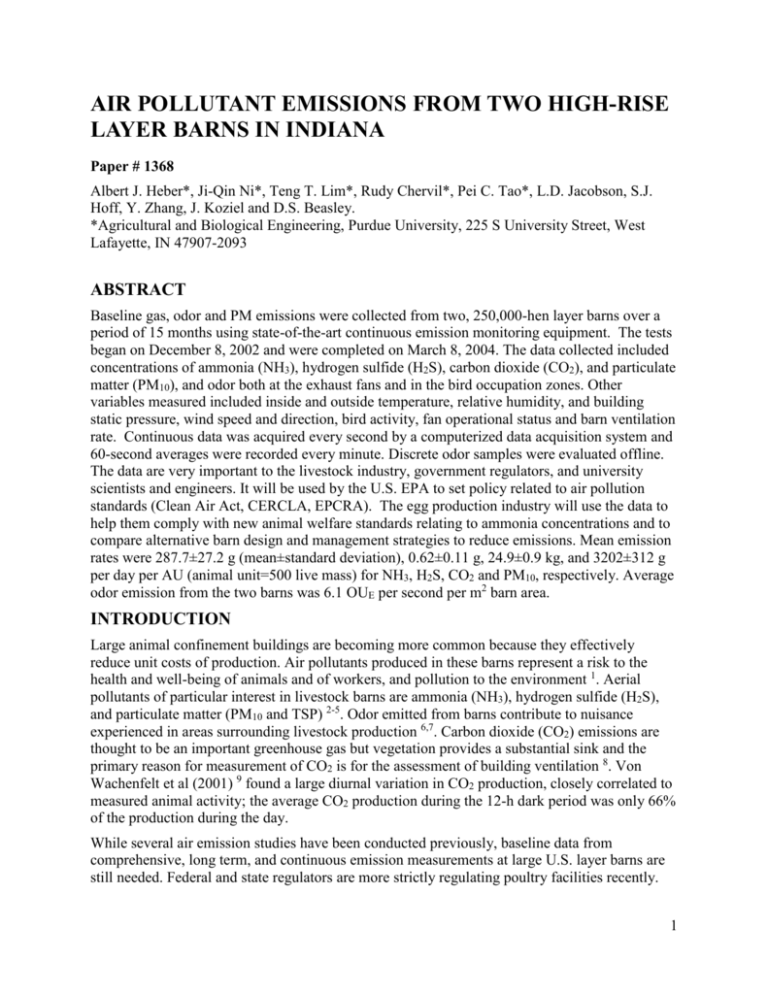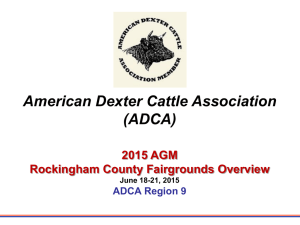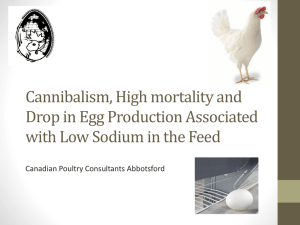AIR POLLUTANT EMISSIONS FROM TWO HIGH
advertisement

AIR POLLUTANT EMISSIONS FROM TWO HIGH-RISE LAYER BARNS IN INDIANA Paper # 1368 Albert J. Heber*, Ji-Qin Ni*, Teng T. Lim*, Rudy Chervil*, Pei C. Tao*, L.D. Jacobson, S.J. Hoff, Y. Zhang, J. Koziel and D.S. Beasley. *Agricultural and Biological Engineering, Purdue University, 225 S University Street, West Lafayette, IN 47907-2093 ABSTRACT Baseline gas, odor and PM emissions were collected from two, 250,000-hen layer barns over a period of 15 months using state-of-the-art continuous emission monitoring equipment. The tests began on December 8, 2002 and were completed on March 8, 2004. The data collected included concentrations of ammonia (NH3), hydrogen sulfide (H2S), carbon dioxide (CO2), and particulate matter (PM10), and odor both at the exhaust fans and in the bird occupation zones. Other variables measured included inside and outside temperature, relative humidity, and building static pressure, wind speed and direction, bird activity, fan operational status and barn ventilation rate. Continuous data was acquired every second by a computerized data acquisition system and 60-second averages were recorded every minute. Discrete odor samples were evaluated offline. The data are very important to the livestock industry, government regulators, and university scientists and engineers. It will be used by the U.S. EPA to set policy related to air pollution standards (Clean Air Act, CERCLA, EPCRA). The egg production industry will use the data to help them comply with new animal welfare standards relating to ammonia concentrations and to compare alternative barn design and management strategies to reduce emissions. Mean emission rates were 287.7±27.2 g (mean±standard deviation), 0.62±0.11 g, 24.9±0.9 kg, and 3202±312 g per day per AU (animal unit=500 live mass) for NH3, H2S, CO2 and PM10, respectively. Average odor emission from the two barns was 6.1 OUE per second per m2 barn area. INTRODUCTION Large animal confinement buildings are becoming more common because they effectively reduce unit costs of production. Air pollutants produced in these barns represent a risk to the health and well-being of animals and of workers, and pollution to the environment 1. Aerial pollutants of particular interest in livestock barns are ammonia (NH3), hydrogen sulfide (H2S), and particulate matter (PM10 and TSP) 2-5. Odor emitted from barns contribute to nuisance experienced in areas surrounding livestock production 6,7. Carbon dioxide (CO2) emissions are thought to be an important greenhouse gas but vegetation provides a substantial sink and the primary reason for measurement of CO2 is for the assessment of building ventilation 8. Von Wachenfelt et al (2001) 9 found a large diurnal variation in CO2 production, closely correlated to measured animal activity; the average CO2 production during the 12-h dark period was only 66% of the production during the day. While several air emission studies have been conducted previously, baseline data from comprehensive, long term, and continuous emission measurements at large U.S. layer barns are still needed. Federal and state regulators are more strictly regulating poultry facilities recently. 1 Therefore, the objective of this paper is to report NH3,H2S, CO2, odor and PM emissions from two modern high-rise caged-layer barns 10. MATERIALS AND METHODS This experiment was conducted in two caged-hen layer barns in north-central Indiana that were located on a farm about 64 km (40 mi.) from the West Lafayette campus of Purdue University. The two barns were constructed in 2002 and measurements were taken with the first group of hens in each barn. Experimental Barns The barns (Barns 13 and 14) were oriented E-W and spaced 75 ft (22.9-m) apart. The roofs of the barns had a 3:12 slope. Each barn was 610 ft x 99-ft. (186.0-m x 30.2-m) and housed 250,000 hens in ten 580-ft (176.8-m) rows of crates (5 tiers high) in the 10.8-ft (3.29-m) high upper floor (Figure 1). Manure was scraped off boards under the cages into the 10.33-ft (3.15 m) high manure pit where it was stored for 24–30 months. Manure drying on the pit was enhanced with 36 in. (918 mm) dia. auxiliary circulation fans (Model #40404-36, Choretime-Brock, Inc., Milford, IN). 2 Figure 1. Front view (top) and floor plan (bottom) of the barns and the measurement set up showing schematically the measurement locations and real-time values during a summer day. Blue dot: air sampling locations and calibration gas inlet; Green dot: locations where air was being sampled; Green oval: ventilation exhaust fans. Ventilation air entered the second floor from the attic through temperature-adjusted baffled ceiling air inlets over the cages. Incoming air passed through evaporative cooling cells (8.92 ft or 2.72 m) in the roof of the attic, which were operated only when all fans were operating and when temperature exceeded a set-point. There were 37 fans (#1-#37) along the west sidewall and 38 fans (#38-#75) on the east sidewall. All fans were 48-in. (122 mm) dia. belted exhaust fans (Aerotech Model AT481Z3CP-24 with 1.0-Hp Motor (PN B-176835-04, General Electric) fans. The fans were 12 ft (3.7 m) apart in groups of three or four fans and most of the groups were 24 ft (7.3 m) apart. Each barn had 15 temperature sensors and was ventilated in 9 stages (Table 1). The first and second stages consisted of 5 and 7 fans, respectively. The cage lights were shut off automatically between 20:00 and 04:00 h each night. Table 1. Fan numbers and ventilation stages for Barn 14*. Stage Number of fans 1 2 3 4 5 6 7 8 5 (continuous) 5+5=10 10+8=18 18+8=26 26+8=34 34+8=42 42+14=56 56+19=75 9 75-19=56 ID of fans for each stage 1, 20, 37, 47, 67 10, 29, 39, 57, 75 5, 15, 24, 33, 43, 52, 62, 71 6, 16, 25, 34, 44, 53, 63, 72 4, 14, 23, 32, 42, 51, 61, 70 7, 17, 26, 35, 45, 54, 64, 73 3, 9, 12, 18, 22, 28, 31, 38, 40, 49, 55, 59, 65, 69 2, 8, 11, 13, 19, 21, 27, 30, 36, 41, 46, 48, 50, 56, 58, 60, 66, 68, 74 Evaporative pads on, stage 8 fans off * Fans for stages 1 and 2 were swapped in Barn 13 to bring a stage 1 fan of each building close to the instrument shelter. Equipment and Measurement Instrument Shelter An air-conditioned trailer of 24 ft x 8 ft x 7 ft (7.32 m x 2.43 m x 2.13 m) located between the two barns was used to shelter instruments and to provide lab and office space for researchers to conduct on-site experiments (Figure 1). The instrument shelter was connected to the barns via two 4-inch (10 cm) ID PVC pipe raceways, which housed sampling tubing and signal cables. The raceways were heated to prevent condensation in cold weather. Gas Concentrations Air was drawn sequentially from different locations in the barns by a gas sampling system and provided to the gas analyzers in the instrument shelter (Figure 2). Six sampling locations in each 3 barn were selected. The sampling location at the cage in each barn was composed of three sampling spots, which were connected together to a manifold, forming a sampling location group along the length of the barn. All other samplings were from single location (Figure 1). Bypass pumping circuit P: pump F: filter M: manifold S: solenoid Teflon tubing (in mm): 9.5 OD 6.4 ID 6.4 OD 3.2 ID 3.2 OD 1.6 ID Vinyl tubing (in mm): 6.4 OD 3.2 ID 22.2 OD 15.9 ID Fittings: Teflon Nylon or other Flow restrictor Exhausts M1 P1 Analyzers NH3 P3 Sampling probes, 10-115 m long S1 H2S 13F29 Bag fill port 14F67 14Cage M3 CO2 (2K) 14Attic F 14F47 14F20 CO2 (10K) 13F59 f M2 13F10 14F1 Mass flow meter P2 13Cage 13Attic Exhaust 13F75 F S12 Exhaust Rotameter (0-350 mL/min) Balance air control valve Mass flow meter Sampling circuit Solenoids are all at un-energized positions P Pressure gage (optional) S13 Pressure sensor Disconnect for leakage test f p Analyzer calibration circuit Cal gases P4 Jar Leak test circuit S14 Figure 2. Flow diagram of air sampling, gas measurement, instrument calibration and system maintenance. Sampling in the attics (one location in each barn at about 10 cm above the baffled ceiling opening) and selected barn stage 1 fans (four fans in each barn) were to determine inlet and exhaust gas concentrations, respectively. The four exhaust sampling locations, about 0.5 m directly in front of the fan at the same height as the fan hub, in each barn included two fans on the west sidewall and two fans on the east sidewall. Sampling in the cages, located in an emptied cage that is about 0.75 m above the 15-cm wide manure slot through which ventilation air enters the pit from the cage area, was to evaluate the bird’s exposure to pollutant gases. Sequence and duration of sampling (10 min each location) were controlled by a computer in the instrument shelter. Ammonia concentrations were measured with a 0-200 ppm chemiluminescence NH3 analyzer (Model 17C, TEI, Inc., Waltham, MA) after conversion to NO. The analyzer sampled at a flow rate of 0.6 L min-1 with an external vacuum pump (Model PU426, KNF Neuberger, Trenton, NJ). Although the nominal range of the NH3 analyzer was 100 ppm, it was increased to 200 ppm by reducing instrument sensitivity by 50%. Hydrogen sulfide (H2S) was first converted catalytically at 400°C to sulfur dioxide (SO2) with a H2S converter (TEI Model 340). The converted SO2 was measured with a pulsed fluorescence SO2 Analyzer (TEI Model 45) according to USEPA Method EQSA-0486-060. A photomultiplier tube detected ultraviolet light emission from decaying SO2 molecules. The SO2 analyzers had a 4 range of 0.05 to 10 ppm, a response time of 60 s (10-s averaging time), and a sample flow rate of 1.0 Lpm. The guaranteed precision was 1% of reading or 1 ppb (whichever is greater). Carbon dioxide was measured with two photoacoustic infrared gas monitors (Model 3600, Mine Safety Appliances Company, Pittsburgh, PA), with 0-2000 and 0-10,000 ppm measurement ranges, respectively. The monitors utilized dual frequency infrared absorption and were corrected for water vapor. Their precision was 2% or ±100 ppm, and sample flow rate was 1.0 Lpm. The monitors had internal pumps and internal filters. All the gas analyzers/monitors were calibrated with zero and certified calibration gases at least once per week. Particulate Matter Particulate matter (PM) was measured with a TEOM ambient PM10 monitors (Model 1400a, Rupprecht & Patashnick, Albany, NY) immediately upstream of Fan #20 in Barn 13 and Fan #59 in Barn 14. The TEOM is a continuous monitoring device and is designated as an equivalent method by the U.S. EPA (EPA Designation No. EQPM-1090-079) for PM10. The TEOM operates on changes in the resonant frequency of an oscillating element as a function of increases in particle mass collected on an attached filter. Changes in the recorded resonant frequency of the element provide continuous and time-averaged measurement of mass accumulation. The device operates at a flow rate of 16.7 L/min, so that it can be outfitted with commercially available preseparator sampling inlets for measuring TSP and PM2.5. Odor Concentration Odor samples were collected using 0.05 mm thick, 10-L, Tedlar bags at the “bag fill port” of the gas sampling system (Figure 2). The bags were flushed with either compressed air or nitrogen gas at least three times prior to the sampling. New bags were used for each sample collection as recommended by the European draft olfactometry standard CEN TC26411. To reduce adsorption losses, 2-3 L of sample air was introduced into each bag and removed before filling the bag with sample air. The samples were evaluated on the same day during a 3.5 h (maximum) olfactometry session. Odor dilutions-to-threshold were measured on the same day with a dynamic dilution forcedchoice olfactometer (AC'SCENT International Olfactometer, St. Croix Sensory, Stillwater, Minn.) according to U.S. olfactometry standards12. The odor panel consisted of eight human subjects that were screened to determine their odor sensing ability13. The olfactometer delivered precise mixtures of sample and dilution air to a Teflon-coated presentation mask at a total flow rate of 20 L/min. The dilution ratio of a mixture was the ratio of total diluted sample flow volume to the odor sample flow volume. The panel average of individual dilutions-to-thresholds was given the concentration units of OU/m3 per the CEN TC264 standard. Fan Operation, Ventilation Airflow and Static Pressures The operating status (on/off) of each fan stage was monitored via auxiliary contacts of fan motor control relays. Fan airflow capacities were measured in the field with a portable fan tester 14 consisting of multiple traversing impellers. The fan tester was calibrated at the University of Illinois Bioenvironmental Systems and Simulations (BESS) Laboratory with an accuracy of ±2%. Additionally, eight impeller anemometers (Model EXAVENT FMS 50, Fancom, 5 Panningen, The Netherlands) were installed inside the top of fan cones of the eight monitored ventilation fans. Static pressures between the center of the manure pit and both the east and west sides of the barns were measured with differential pressure sensors (Model 267, Setra, Boxborough, MA). The sensors’ measurement range were ±100 Pa with an accuracy of ±0.25%. Relative Humidity, Temperature, and Wind One capacitance-type relative humidity (RH) and temperature probe (Model HMW61, Vaisala, Inc., Woburn, MA) was set up at the same sampling locations as the TEOM in each barn. Another RH/T probe (Model Humitter 50Y, Vaisala, Inc.) was located in one emptied cage in the middle of each barn. A solar radiation shielded RH/T probe (Model HMD60YO, Vaisala, Inc.) and a cup anemometer and wind vane were attached to the top of one feed bin near the instrument shelter. Thermocouples (Type T) were installed to measure temperatures at the baffle air inlet and at exhaust fan locations, where RH/T probes were not set up. Thermocouples were also installed in the heated raceways between the barns and the instrument shelter, inside the instrument shelter, and the shelter compartment where TEOM and ammonia analyzer sampling pumps were housed. Data Acquisition and Control A special data acquisition (DAQ) and control program was developed for this study using LabVIEW for Windows (National Instruments Co., Austin, TX). The program ran in a PC and communicated with DAQ hardware, which included a bank of FieldPoint modules (National Instruments Co.), and a PCI 6601 DIO card (National Instruments Co.). A PCIM-DAS1602/16 DAQ card and an expansion board (EXP 32, Measurement Computing Corporation, Middleboro, MA) was also installed to add additional 32 analog input channels. Data acquired by the DAQ system were sampled at a frequency of 1 Hz, then averaged every 15s and 60s, and saved into two data files, respectively. Saved in the data files were also time stamps and air sampling locations. Data Processing Custom data processing software CAPECAB was used to process the 1-min data set 15,16. Gas concentrations of each sampling location or location group were divided into invalid data, at the beginning of the 10-min sampling cycle, and valid data, at the end of the cycle. The duration of invalid data depends on the time required for equilibrium of the measurement system, especially the gas analyzer. The valid gas concentration data was extracted for emission calculations (Table 2). There were only 3 to 7 valid readings per emission stream during a 120-min sampling cycle. Gas concentrations in the intervals between valid readings were estimated by linearly interpolating between valid readings. The maximum interval of missing data that was interpolated was 300 min. PM and odor concentrations were converted to concentrations at STP (20°C, 1 atm) for calculating emissions. 6 Table 2. Extraction of gas concentration data. Gas Ammonia Hydrogen sulfide Carbon dioxide Invalid time (min) Valid time (min) 7 5 3 3 5 7 The calculation of emission with a single ventilation exhaust sampling location was: E QoCo QC i i Q ' oC ' o Q 'i C 'i (1) Where, E, Ci Co Ci’ Co ’ Qo Qi Qi’ Qo’ Barn emission rate, mg/s or µg/s Mass concentration at the barn air inlet, mg/m3 or µg/m3 Mass concentration at the barn air exhaust, mg/m3 or µg/m3 Standardized mass concentration at the barn air inlet (based on STP), mg/sm3 or µg/sm3 Standardized mass concentration at the barn exhaust (based on STP), mg/sm3 or µg/sm3 Barn outlet moist airflow rate at To, m3/s Barn inlet moist airflow rate at Ti, m3/s Moist standard ventilation rate at the barn inlet (based on STP), sm3/s Moist standard ventilation rate at barn exhaust (based on STP), sm3/s The barn emission rate with multiple sampling locations corresponding to multiple ventilation exhausts was: n E Qo ,k Co ,k Ci (2) k 1 Where, E Co,k Ci Qo,k Gas emission rate from the barn, mg/s Mass concentration at a specific ventilation exhaust k, mg/m3 or µg/m3 Mass concentration in the incoming ventilation air, mg/m3 or µg/m3 Ventilation rate corresponding to concentration measurement location k, m3/s To avoid errors introduced into the calculated average values due to partial data days (e.g. only 3 night time hours of valid data) that resulted in biased time weights, only complete-data days that include over 70% valid data was used for calculating average daily means (ADM). RESULTS AND DISCUSSION Table 3 presents partial results of gas and PM10 emissions, from August 13 to November 23, 2003 (a total of 105 days), of the 15-month measurement campaign. The complete data days of the gases and PM ranged from 57 to 97 days, about 54% to 92% of the measurement period. Ammonia emission rate from Barns 13 and 14 were 278.8±33.8 and 298.3±43.8 g per day per AU (animal unit=500 kg live mass), respectively, only less than 7% difference. Lim et al. 7 (2004) 5 studied NH3 emission from a 250,000 layer barn from September 2001 to May 2002. The average NH3 emission rate from 125 complete data days of data was 200 g/d-AU. It was only about 70% of the average emission rate of Barns 13 and 14. Hydrogen sulfide emission rates were low from both barns, 0.49±0.09 g/d-AU from B13 and 0.75±0.19 g/d-AU from B14. Hydrogen sulfide is not a major concern among air pollutants emitted from poultry barns. The mean H2S emission rate from a 250,000-hen layer barn reported by Lim et al. (2003) 17 was 5.6 µg/s-AU or 0.48 g/d-AU, which was similar to the emission rate from Barn 13. Barn 14 emitted 53% more H2S than Barn 13. The range of CO2 from the two barns using two carbon dioxide monitors was from 24.5±1.3 to 25.0±1.4 kg/d-AU. The average emission rate from the two barns with the two monitors was 24.9±0.7 kg/d-AU. Table 3. Emission rates of ammonia, hydrogen sulfide, carbon dioxide and PM10 from the two barns. Pollutant Barn Complete data Days Emission rate per day per AU* NH3 B13 B14 Mean B13 B14 Mean B13 B14 Mean B13 B14 Mean B13 B14 Mean 69 57 278.8±33.8 g 298.3±43.8 g 287.7±27.2 g 0.49±0.09 g 0.75±0.19 g 0.62±0.11 g 25.0±1.4 kg 24.9±1.5 kg 25.0±1.0kg 24.5±1.3 kg 25.1±1.3 kg 24.8±0.9kg 2878±334 g 3489±501 g 3202±312 g H2S CO2 (2k) CO2 (10k) PM10 72 68 77 67 75 73 86 97 * Mean±95% confidence interval. PM10 emission was higher from Barn 14 (3489±501 g/d-AU) than Barn 13 (2878±334 g/d-AU). Odor emissions from five days of sampling, three samples each day in each barn, are listed in Table 4. Barn odor emission rates ranged from 3,898 to 109,683 OU/s (OU=Odor Unit), or from 4,898 to 100,138 OUE/s (OUE=European Odor Unit). Averaged odor emissions per unit area were 6.5 and 7.9 OU/s-m2, or 5.6 and 6.7 OUE/s-m2, for Barn 13 and Barn 14, respectively. These emission values were lower than the 7.53 OUE /s-m2 reported by Lim et al. (2003)17. Table 4. Odor emission rates from the two barns. Date Sample # B13 OU/s B13 OUE/s B14 OU/s B14 OUE/s 8 8/18/2003 9/2/2003 9/15/2003 9/29/2003 10/13/2003 10/31/2003 11/14/2003 Mean Min Max Emission per m2 1 2 3 1 2 3 1 2 3 1 2 3 1 2 3 1 2 3 1 2 3 70538 48055 71205 57818 66050 75993 24162 20174 19951 26501 35571 13562 3898 10086 10217 74870 53060 53064 11447 10381 9397 36476 3898 75993 6.5 62248 42407 62836 36744 41977 48296 19953 16659 16476 19902 26713 10184 4898 12674 12839 84135 59626 59630 8499 7707 6977 31494 4898 84135 5.6 41312 47936 47924 97921 98846 109683 36861 23065 27303 36934 40498 18769 4512 4590 63611 63372 89111 8840 12102 12175 44268 4512 109683 7.9 36456 42302 42291 62231 62819 69706 35897 23222 27134 24446 26865 12127 5670 5768 71483 71215 100138 6563 8985 9039 37218 5670 100138 6.7 CONCLUSION The following air pollutant emission data were obtained from the two barns during 105 days. 1. Ammonia emission from Barns 13 and 14 were 278.8±33.8 and 298.3±43.8 g/d-AU, respectively. 2. H2S emission rates were 0.49±0.09 and 0.75±0.19 g/d-AU from B13 and B14. 3. The range of CO2 from the two barns was 24.5±1.3 to 25.0±1.4 kg/d-AU. The average emission rate from both barns was 24.9±0.7 kg/d-AU. 4. PM10 emission was higher from Barn 14 (3489±501 g/d-AU) than Barn 13 (2878±334 μg/d-AU). 5. Mean odor emissions were 6.5 and 7.9 OU/s-m2, or 5.6 and 6.7 OUE/s-m2, for Barns 13 and 14, respectively. 9 ACKNOWLEDGMENTS The authors would like to thank the United States Department of Agriculture for funding this research project under the USDA-IFAFS research and demonstration program. This work is dedicated to the memory of the late Dr. Bob Bottcher, our colleague and friend. REFERENCES 1. 2. 3. 4. 5. 6. 7. 8. 9. 10. 11. 12. 13. 14. 15. 16. 17. McCubbin, D. R.; Apelberg, B. J.; Roe, S.; Divita, F. Environ. Sci. Technol. 2002, 36, 11411146. Maghirang, R. G.; Manbeck, H. B. In ASAE Int. Summer Meeting; ASAE, 2950 Niles Rd., St. Joseph, MI 49085-9659 USA: Spokane, Washington, 1993; p 11. Heber, A. J.; Lim, T. T.; Gallien, J. Z.; Ni, J.-Q.; Tao, P. C.; Jacobson, L. D.; Koziel, J. A.; Hoff, S. J.; Zhang, Y.; Baughman, G. B. In Symposium on Air Quality Measurement Methods and Technology: San Francisco, CA, November 13-25, 2002; p 14. Keener, H. M.; Elwell, D. L.; Grande, D. Transactions of the ASAE 2002, 45, 1977-1984. Lim, T. T.; Heber, A. J.; Ni, J.-Q. In A&WMA’s 97th Annual Conference & Exhibition: Indianapolis, Indiana, 2004; p 9. Schmidt, D. R.; Guo, H.; Jacobson, L. D. In Odors and VOC Emissions 2000: Hyatt Regency, Cincinnati, Ohio, USA, 2000. Nahm, K. H. Avian Poult Biol Rev 2003, 14, 151-174. Alchalabi, D. A.; Person, H. H.; Rhan, A. AMA, Agriculturala Mechanization in Asia, Africa and Latin America 1996, 27, 71-74. Von Wachenfelt, E.; Pedersen, S.; Gustafsson, G. British Poultry Science 2001, 42 (2): 171179 May. Heber, A. J.; Ni, J.-Q.; Lim, T. T.; Tao, P. C.; Millmier, A. M.; Jacobson, L. D.; Nicolai, D. E.; Koziel, J. A.; Hoff, S. J.; Zhang, Y.; Beasley, D. B. In Symposium on Air Quality Measurement Methods and Technology: San Francisco, CA, November 13-25, 2002. ECN "Air quality - Determination of Odour Concentration by Dynamic Olfactometry," CEN, European Committee for Standardisation, Central Secretariat: Rue de Stassart 36, B1050, 2000. ASTM Committee E-18 In Annual Book of ASTM Standards; American Society for Testing and Materials: Philadelphia, 1992; Vol. 15.07, pp 35-39. ASTM Committee E-18 Guildlines for the selection and training of sensory panel members. ASTM special technical publication 758; American Society for Testing and Materials: Philadelphia, 1981. Casey, K. D.; Wheeler, E. F.; Gates, R. S.; Xin, H.; Topper, P. A.; Zajaczkowski, J.; Liang, Y.; Heber, A. J.; Jacobson., L. D. In Symposium on Air Quality Measurement Methods and Technology; Air and Waste Management Association: Pittsburgh, PA: San Francisco, CA, 2002. Eisentraut, M. A.; Heber, A. J.; Ni, J.-Q. In A&WMA’s 97th Annual Conference & Exhibition: Indianapolis, Indiana, 2004; p 18. Eisentraut, M. A.; Heber, A. J.; Lim, T. T.; Hoff, S. J. In A&WMA’s 97th Annual Conference & Exhibition: Indianapolis, Indiana, 2004; p 10. Lim, T. T.; Heber, A. J.; Ni, J.-Q. In International Symposium on Control of Gaseous and Odor Emissions from Animal Production Facilities: Horsens, Denmark, 2003; pp 273-282. 10







